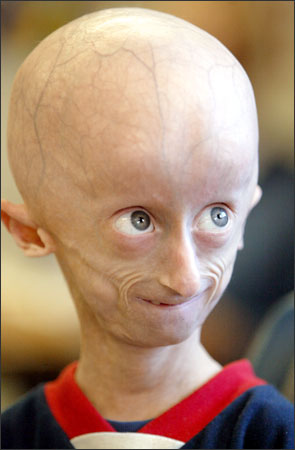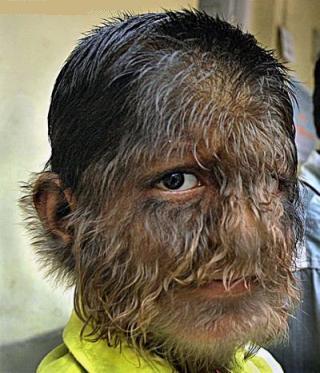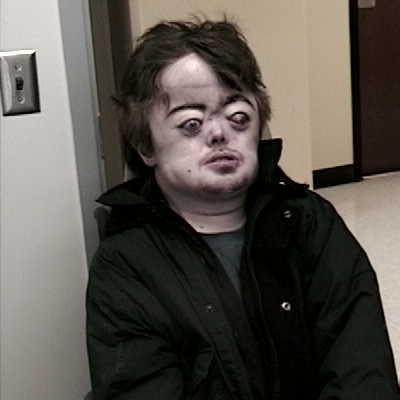Top 14 Strangest Diseases - You might not have heard about them
By: Stefan Anitei, Science Editor - Softpedia

Elephatiasis affecting the feet, scrotum and hands
1. Elephant people. Elephantiasis is a parasite disease caused by worms called filariasis, that block the lymphatic vessels. When the lymph vessels cannot be drained, the accumulated liquid induces changes into the surrounding tissues translated into grossly enlarged or swollen arms, legs, breasts and genitalia. There are three related nematode parasitic worms causing the disease: Wuchereria bancrofti (Africa and South America), Brugia malayi, and B. timori (in Asia), all transmitted through the bite of the mosquitoes.
120 million people worldwide in the tropical areas live with elephatiasis (mainly in Africa), and 40 million of them experience severe health issues. The worm larvae, called microfilariae, enter the bloodstream from the mosquito saliva. The microfilariae spread throughout the bloodstream, and live for many years, usually causing elephantiasis symptoms years after infection.
There is also a nonparasitic form of elephantiasis, called podoconiosis, that occurs in the mountains of central Africa, and which is caused by persistent contact with volcanic ash.

Unilateral elephatiasis for one breast
2. Progeria is a genetic disorder that can make a 10-year-old child look like he were 80. A sole minute defect in a child's DNA has this horrible effect. The patients usually die before reaching 13.
The children's body experiences a strikingly rapid aging phenomenon, including all age-related symptoms and diseases, like premature baldness, wrinkles, heart disease, osteoporosis and arthritis. Progeria patients have specific symptoms such as small face and jaw and pinched nose. The condition is extremely rare, only about 48 people with progeria are known worldwide. The mutation can be transmitted to children: in one case, there were five children with this disease inside the same family. Usually, the mutation occurs in the germ cell or embryo.
3. One percent of men is affected by Peyronie's disease (curbed penis), a connective tissue disorder translated into the growth of fibrous plaques in the soft tissue of the penis and which induces throbbing erections and difficult sexual intercourse.
The causes are not clearly known, but it may be induced by damage to the inner cavity of the penis, resulting in an over production of scar tissue in the corpora cavernosa and an abnormal twist of the penis. Trying to bend or force the erect penis back to its former shape can provoke serious injury and significantly worsens the condition.
The most common causes for penis injuries are reported to be bending it during the intercourse, especially when the woman is on top, during sports activities where an accidental impact took place or by drumming the penis. Some consider the disease to be genetic as it was reported in men who refute any sexual activity or physical wound.
About 30 % of men with Peyronie's disease display fibrosis in other elastic tissues of the body, like on the hand or foot, including Dupuytren's contracture of the hand, pointing to a hereditary component of the disease. Peyronie's emerges as a plaque or hard lumps formed on the upper or on the lower side of the penis in the erectile tissue. At the beginning, the plaque can be like an irritation which hardens and transforms into a mark. But most cases develop slowly or even vanish on their own, but symptoms may expand and become visible overnight.
Peyronie's can vary from mild to severe. While most men will continue to be able to have sexual relations, they are likely to experience some degree of deformity and erectile dysfunction in the wake of the disease process. The disease occurs mainly in men aged 40-60 years. The scar tissue is hard and inelastic, unlike the elastic erectile tissues of the penis permitting expansion and reduction for erection. In time, increased scar tissue mass starts pulling or contracting the penis, inducing hard lumps or a curvature deformity.

Progeria
4. The Werewolf Syndrome: the wolf people, which have the face and body covered by hair. In Mexico, all the men in a family had hair that covered their faces and upper bodies.
The facial and body hair can be longer than three-inches (8 cm), but it does not induce any itch or rash on the skin and it is not accompanied by any odor or skin disorder.
The condition is supposed to be an atavism. Atavisms usually appear because genes for previously existing phenotypical traits are not discarded from the genome, but often preserved and just inhibited by our DNA. Even if these genes are not expressed, a mutation can reactivate them.
Atavisms that have been found in humans are for example babies born with a vestigial tail, named "coccygeal process", "coccygeal projection", and "caudal appendage", but other atavic traits in humans can be the presence of large, ape-like canines, the development of claws instead of nail or the presence of more than one pair of mammary glands.
5. Blue Skin Disorder was detected in a large family living in the hills around Troublesome Creek in Kentucky until the 1960s, called Fugates. They were over 80 years old when they died, without any severe disease, except for the fact they had blue skin, a genetic trait transmitted from generation to generation. Their skin color varied from blue to plum, indigo or almost purple skin.
6. Pica ("magpie" in Latin) is a disease characterized by the appetite for non-food substances. These people will eat anything, like a magpie, from non-food substances like dirt, paper, coal, soil, chalk, glue and clay but will also have an abnormal appetite for stuff that could be considered foods, like food ingredients (e.g., flour, raw potato, starch), for over a month at an age where ingesting these objects is not developmentally normal.
Pica affects especially pregnant women and small children, especially those developmentally disabled. It was believed to be connected to mineral deficiency, but health experts have encountered no real cause and no cure for this disorder. Pica is dangerous, as it can cause poisoning and gastro-intestinal obstruction or stomach tearing, but also infestation from animal feces with parasites.
7. Coprophagia is the eating of feces. It is extremely rare, and has been seen in very few patients with dementia, schizophrenia and depression. The ingestion of other people's feces can induce infections spread through feces, like Hepatitis A, Hepatitis E, pneumonia, and influenza, bacteria and parasitic worm eggs.

Werewolf case
Bedouins use fresh camel feces as a remedy for bacterial dysentery; and its efficacy could be due to the antibiotic subtilisin from Bacillus subtilis.
8. Vampire Disease: pain caused by the sun. Even if they do not feed on blood, if they are caught in the sun, their skin will blister, sometimes as soon as they are exposed to sunlight. The disease is extremely rare.
9. Alice in Wonderland syndrome (micropsia), is a visual neurological disease.
Patients see objects much smaller than they really are. The object perceived seems far away or extremely close at the same time. A dog or a car may seem as big as a mouse. The Lilliput sight (Lilliputian hallucinations) is not caused by impairment in the eyes, but on the brain's interpretation of the information received from the eyes.
Micropsia affects especially 5 to 10 year-old-children and schizophrenic patients, and installs especially during darkness, and can affect also hearing, touch, and own body image; and the sensations continue even when the eyes are closed. Secondary effects are anxiety, apraxia (lack of movement), and agnosia (loss of recognition). Micropsia is also commonly related to patients suffering from schizophrenia.
10. Blaschko's lines is an extremely rare genetic condition. The skin or mucosa present a stripe pattern, not linked to nervous, muscular, or lymphatic systems. The stripes usually form a "V" shape over the spine and "S" shape over the chest, stomach, and lateral parts.
11. Walking Corpse Syndrome is a syndrome linked to depression, in which the patient feels he/she has lost everything: possessions, body parts, often thinking he/she has died and is a walking corpse, and the patient can even "feel" the smell of his own rotting flesh and worms eating it. The latter symptom is also experienced by people chronically deprived of sleep or with amphetamine/cocaine psychosis. The "dead" stage makes patients feel immortal.
12. In the Amazon area, the most feared fish is not piranha or the electric eel, but a fish not longer than 17 cm (7 inch) and just 4-6 mm wide. It is the Vampire Catfish, Candirú or Canero (Vandellia cirrhosa). This fish looks like an eel larvae, being almost completely transparent, and impossible to see in clear water, not to mention the turbid waters of the Amazon.
When resting, the candirú stays buried in muddy bottoms. A fast, powerful swimmer, the fish possesses sharp teeth and backward-pointing spines on its gill's opercle. The candirú is a parasite fish, that attacks the gills of large fish, but it can also enter one of his/her body orifices (the vagina, rectum, or even the penis—and deep into the urethra) and due to the opercle's spines protruding from the fish, it is almost impossible to take out the fish, except through surgery.

Apert syndrome
The fish tracks down its host by following a water scent to its source and urinating while bathing increases significantly its chance of entering the human urethra. That's why Indians bathe facing the current, decreasing candirú’s chances of entering in the rectum, while the penis or vagina are covered up with the hands.
Even if candirú’s attacks on humans are known, it is not proven that the fish can actually survive once inside the human body.
13. Self-cannibalism (Lesch-Nyhan syndrome) is characterized by "self-mutilating behaviors, characterized by lip and finger biting". 60 % of Lesch-Nyhan patients have to have their teeth removed to impede them from biting off their lips, cheeks, tongues, and other parts.
14. The Apert syndrome is induced by a mutation in the sperm that stops skull growth and induces joined fingers and toes, as the same mutation also spurs the division rhythm of the cells that form sperms.
One in every 70,000 children is born with the Apert syndrome, translated into fused bones in the head, hands and feet. The DNA change occurs on a sole gene on chromosome 10 and is connected to the father's age. The syndrome induces achondroplasia dwarfism, in which the soft organs are normally developed, but the bones undeveloped, resulting in a SF appearance.
Linkback:
https://tubagbohol.mikeligalig.com/index.php?topic=4615.0